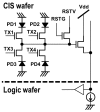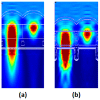A 45 nm Stacked CMOS Image Sensor Process Technology for Submicron Pixel
- PMID: 29206162
- PMCID: PMC5751557
- DOI: 10.3390/s17122816
A 45 nm Stacked CMOS Image Sensor Process Technology for Submicron Pixel
Abstract
A submicron pixel's light and dark performance were studied by experiment and simulation. An advanced node technology incorporated with a stacked CMOS image sensor (CIS) is promising in that it may enhance performance. In this work, we demonstrated a low dark current of 3.2 e-/s at 60 °C, an ultra-low read noise of 0.90 e-·rms, a high full well capacity (FWC) of 4100 e-, and blooming of 0.5% in 0.9 μm pixels with a pixel supply voltage of 2.8 V. In addition, the simulation study result of 0.8 μm pixels is discussed.
Keywords: dark current; full well capacity; image sensor; optical crosstalk; random telegraph noise; read noise; stacked CMOS image sensor; submicron pixel.
Conflict of interest statement
The authors declare no conflict of interest.
Figures

















References
-
- Fossum E.R. What to do with sub-diffraction-limit (SDL) pixels?—A proposal for a gigapixel digital film sensor (DFS); Proceedings of the IEEE Workshop on Charge-Coupled Devices and Advanced Image Sensors; Nagano, Japan. 8–11 June 2005; pp. 214–217.
-
- Kobayashi M., Johnson M., Wada Y., Tsuboi H., Ono T., Takada H., Togo K., Kishi T., Takahashi H., Ichikawa T., et al. A Low Noise and High Sensitivity Image Sensor with Imaging and Phase-Difference Detection AF in All Pixels. ITE Trans. Media Technol. Appl. 2016;4:123–128. doi: 10.3169/mta.4.123. - DOI
-
- Ahn J.C., Moon C.R., Kim B., Lee K., Kim Y., Lim M., Lee W., Park H., Moon K., Yoo J., et al. Advanced image sensor technology for pixel scaling down toward 1.0 µm (Invited); Proceedings of the IEEE International Electron Devices Meeting; San Francisco, CA, USA. 15–17 December 2008; pp. 1–4.
-
- Wuu S.G., Wang C.C., Hsieh B.C., Tu Y.L., Tseng C.H., Hsu T.H., Hsiao R.S., Takahashi S., Lin R.J., Tsai C.S., et al. A leading-edge 0.9 µm pixel CMOS image sensor technology with backside illumination: Future challenges for pixel scaling; Proceedings of the IEEE International Electron Devices Meeting; San Francisco, CA, USA. 6–8 December 2010.
LinkOut - more resources
Full Text Sources
Other Literature Sources

